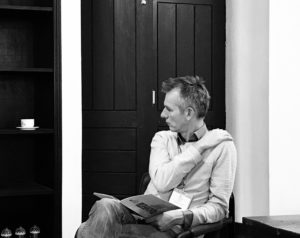Author’s note:
The following tentative reflections were written in 2003 for a German jubilee volume edited on the occasion of Alokeranjan Dasgupta’s 70th birthday.[1] A modified and abridged Bengali version appeared in Deś patrikā in 2008.[2] I am grateful to Ranjita Chattopadhyay for her English translation of the Bengali version for Antonym, and to the latter’s editor Biswadip Chakraborty for inviting me to republish the text in English as my token of respect and friendship to the poet after his death. Alokeranjan Dasgupta wrote poems virtually until his last days before passing away in November 2020, making these remarks even more tentative
[1] Hans Harder (2003): ‚Verquere Vögel und ein taxierendes Ich: Einige Überlegungen zur Lyrik von Alokeranjan Dasgupta‘. In: Franz Schneider (Hg.): Trauben aus Elfenbein. Festschrift für Alokeranjan Dasgupta. Heidelberg: Draupadi Verlag; 77-83.
[2] Hans Harder (2008): ‚Kabitār āmi o kabir āmi‘.Deś, Baï saṃkhyā, February 2, 2008; 63-66.
Alokeranjan Dasgupta’s poetry is both fascinating and difficult. There is no passe-partout, or general key, for decoding it – not because it lacks codes, but rather because the codes themselves are not fixed and seem in continuous flux. His poetry is playful and oscillating to a high degree, and in a way constantly redefines itself anew. So strictly speaking, we cannot set up any rules for its interpretation; what we can do, at best, is reconstruct some of its moves. This is what I want to try briefly in the following: I want to show how Alokeranjan frequently dissolves common ontological categories, such as gods, humans, plants, etc., and stages collisions of opposed domains, such as lyrical and day-to-day speech, or micro- and macrocosms. Such contrasting procedures help to generate the characteristic polyphony of his poetry. The lyrical “I” is part of this polyphony. At times it assumes positions or serves as a distancing feature, but often it remains just one voice among others.
Let us start these reflections with the poem ‘Sonār bāchur’ (Golden Calf) from his award-winning book Maramī karāt (The Mystical Saw, 1990):
A calf bucks, kicks the sleeping sun
and suddenly the morning breaks upon the world.
We few have trapped that golden calf with our nets
Loaded it on a jeep
We’ll chuck it out once we reach Kolkata.
The land-writ of God, that mobile temple
will roam the alleys and
wake the sun with its gentle kick.
This poem is full of disruptions of conventional ideas. A huge animal is in charge of the natural laws here. How can a net capture this creature? How can it be loaded in a jeep? How can a temple be mobile? Alokeranjan intertwines very different spheres here. The calf is roaming in the vast cosmic realm of the rising sun and the narrow alleys of Kolkata at the same time. Endowed with a semblance of biblical heresy, it swings to and fro between the profane space inside a jeep and and the sacred space of the temple. The moving temple reminds the readers of the Bengali Bauls or of certain ideas of Kannada Bhakti saints, according to whom the body is the temple, a place of worship, and wanders in different countries like a jaṅgama monk.
The temple is not the only concept that Alokeranjan unsettles and sets in motion:
In this city there are nine hundred thousand secret splendid chambers,
and in their hollows many intense games are being played on us.
But the depressed stadium wanders wearily on the streets,
seeking a player impartial to the teams.
In this poem titled ‘Śaraṇārthīr ārji’ (The Appeal of a Refugee, 1991), many things are turned on their head. In the quoted stanza, it is a stadium that is being driven through the streets. The abolition of the opposition between immobile and mobile can in this instance be read as signaling an extreme situation that upsets the fabric of various matters of course. Elsewhere it is a house that is set in motion:
Someone called and passed by at the last hour of the night
carrying ginger tea in a clay cup
he didn’t speak to anyone about how penniless he’s become.
At the slamming of his non utterance
our house turned into a train compartment,
the courtyard platform, the road station.
Without asking for your permission, I send the house off
and then start running parallel to the man.
I wish to come back home one day, after fulfilling some of his hopes,
but I wonder, would the returning compartment be tied down at its source by then?
In this poem titled ‘Bāṛiṭāke raonā kare diẏe’ (After sending the house off, 1993), the house is not a piece of architecture, but rather an affective category. The job of the house is to welcome and protect even those who run away. So Alokeranjan changes its structure and transforms it into a train or a station, apt for offering its shelter to fleeing people.
In the poems discussed so far, Alokeranjan portrays motionless objects in a state of motion. He relishes turning common notions of spatial fixity into an ambivalent, fluid state of aggregation. Similar things happen to other categories also: established spheres are dissolved, leading to unforeseen encounters. This happens, for instance, in the bibhāb kabitā ‘Now the shadow of the house lay floating upon the house’ (1988), in which the gods become refugees. They come down to earth in parachutes to take part in a game against humans:
Now the shadow of a house lay floating upon the house
Is it a house? Is it a ship? We can’t really tell.
All we see is that on its deck
gods and humans are changing sides constantly,
wearing the same jersey.
The first half of that rousing match is over;
Look, the humans are somewhat ahead.
The conventional hierarchy of realms of existence is abolished here. The sheer destruction that is dealt with in the first part of the poem does not only cause another flood that transforms the roof of the house into a deck. It also shakes the pantheon and forces the gods to climb down and assert their dignity in the shape of sportsmen. In such fashion, Alokeranjan repeatedly brings about the collision of different spheres: massive and tiny, divine and human, unidimensional and multidimensional, unison and polyphonic.
Polyphony can be a problem, threatening to explode the limits of feasibility and becoming a cacophony, as in his poem called ‘Saṅglāpikā’ (Conversation, 1998):
There’s only one telephone in your foothills
there’s only one line for those who talk and those who listen.
That’s why the telephone booth fell apart under waves of crowds
And in those waves I see them entering, creatures of the ocean,
deer or a newborn God.
And they speak together, among each other
It isn’t preferable if you ask me, to have such unity
Besides, one really can’t tell who’s talking, and to whom.
Even though it was quite peaceful visiting your model foothills,
Upon my return to the city I kept them divided- the speakers and the listeners;
Let me speak first,
I’ll listen to you in a while.
This poem ironically depicts an explosion of limitless communication: the ‘I’ has to take charge in order to maintain the basic rules of communication. The world of Alokeranjan’s poetry does not always neatly fall into subjects and objects, and the ‘I’ at times has to convulse so as to remain the master of events.
In the poem ‘Balechilām’ (I had said, 1991), again, the ‘I’, immersed in reflections and thoughts, rises to regulate polyphony, but simultaneously apologizes for not being entirely able to do so:
I told you that after the Gulf War, this third great war, a new dimension of aesthetics would develop. As a result, every poem would be born from the fire of conscience enflamed by the death of millions of innocent people. I told an utter lie. None of that has happened. What has increased instead is the abundance of all kinds of weird birds, creepers and leaves. […] Some names of birds and flowers will also creep into my sentences: forgive me for that.
There are indeed many such weird birds, flowers and trees in Alokeranjan’s poems, and not just a few names. In speaking of polyphony I consciously refer to the Russian author and philosopher Mikhail Bakhtin who originally introduced the concept to the theory of the novel. I think this multiplicity of voices is nothing less than constitutive of Alokeranjan Dasgupta’s poetry. Polyphony highlights one aspect of the latter because notwithstanding its decisive stylistic uniqueness, Alokeranjan’s poetry always remains receptive to the outer world.
It is interesting to look at Alokeranjan’s use of the ‘I’ in this connection. Sometimes this ‘I’ is the means to assume a position face to face to that polyphony. Sometimes it emerges from primary speech genres (to use one of Bakhtin’s terms), for instance when it converses with a ‘you’; but in most cases it is on its own. Occasionally it runs to the middle of the playground of a poem and takes control of the entire field, as for example in ‘Tuṣār haki” (Ice hockey, 1973) where it hastens all alone towards the goal, or in the poem ‘Buddhapūrṇimā rātre’ (The night of Buddhapurnima, 1998) on the Pokhran nuclear bomb tests of that year.
I can think of only one poem where this lyrical “I” is entirely centre-stage from the start and throughout. It is tellingly called ‘Āmār kintu chimchām paripārśva cāi’ (I need tiptop surroundings, 1993), and is about a householder who, before the wedding of the “neighborhood’s princess,” clandestinely tastes all the dishes of the wedding feast and makes sure that all the arrangements are perfect. The poem ends like this:
Is the cooking done? Look, people who have been driven away from all over the world have come; it is good that the minister of the environment is my former student, I will go as far as Kerala to get him extra banana leaves. When everyone, happy and satisfied, sits down to enjoy the meal, I will with utmost joy write a melancholy poem …
In sum, we notice that Alokeranjan’s lyrical “I” does not have a static and set position, but retains its irrepressible capability of metamorphosis. It always defines its position anew amongst a multitude of tones and voices. It observes its surroundings and moves as one of several actors through a wide and open landscape.
This communicative openness is where the poems and their author meet: it is this unending process of creative and humorous verbalization and communication that characterizes the man Alokeranjan Dasgupta and his poetry alike. The poem does not circumscribe itself, it shall speak; the text does not close itself, but shall set out into the world. Just like the dancer in the poem ‘Hāoẏār pā’ (Feet of the Air, 1988), who is told in the end:
Once you easily master
The difficult footwork,
You have to step down from the stage into life.



























0 Comments